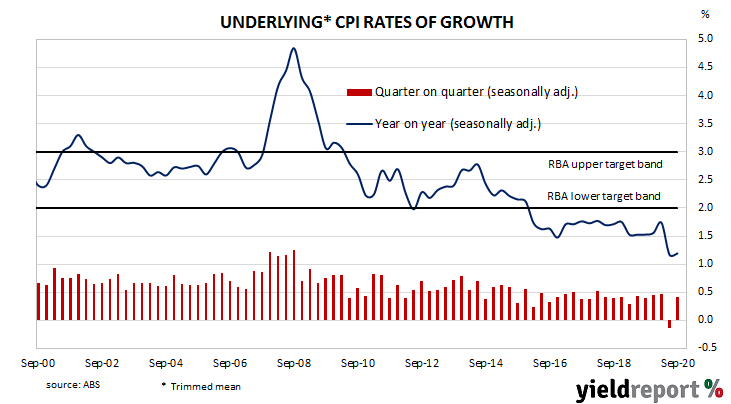Summary: Inflation restarts in September quarter after deflation hits June quarter; RBA preferred measure also back in positive territory; childcare main driver of result; result generally expected by economists, seen as “one-off”.
In the early 1990s, entrenched inflation in Australia was broken by the “recession we had to have” as it became known. Since then, core consumer price inflation has averaged around 2.3%, a little below the midpoint of the RBA’s target range of 2%-3%. Following the GFC, various measures of consumer inflation have been in a down-trend despite attempts by the RBA to increase them through historically low cash rates.
Consumer price indices for the September quarter have now been released by the ABS and both the headline and seasonally-adjusted figures were roughly in line with market expectations. The headline inflation rate came in at +1.6% for the quarter, in marked contrast to the June quarter’s -1.9%. The seasonally-adjusted inflation rate also accelerated significantly, from a revised rate of -1.8% to +1.5%. On a 12-month basis, the headline rate registered +0.7%, as did the seasonally-adjusted rate. In the June quarter, their respective rates were -0.3% and -0.4% after revisions.
The RBA’s preferred measure of underlying inflation, the “trimmed mean”, also reverted to positive territory. The trimmed mean inflation rate for the September quarter was +0.4%, slightly below the market’s expected figure of +0.5% but a turnaround from June’s -0.1%. The 12-month growth rate remained unchanged at 1.2%.

Commonwealth Government bond yields generally moved a touch lower, although not as much as their US counterparts had in overnight trading. By the end of the day, the 3-year ACGB yield had ticked up 1bp to 0.17%, the 10-year yield remained unchanged at 0.79% while the 20-year yield finished 1bp lower at 1.39%.
Expectations of the path of the actual cash rate remained largely unchanged. By the end of the day, contracts implied the cash rate would fall below 0.10% in November, then decline a little further in December and 2021.
The main driver of the headline inflation figure in the quarter was a 12% rise in furnishings, household equipment and services. This segment includes childcare, which added just under 1 point, or 0.8%, to the index over the quarter.

